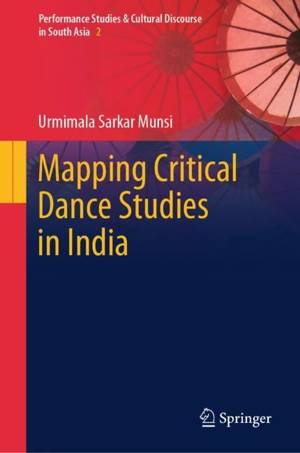
Wil je zeker zijn dat je cadeautjes op tijd onder de kerstboom liggen? Onze winkels ontvangen jou met open armen. Nu met extra openingsuren op zondag!
- Afhalen na 1 uur in een winkel met voorraad
- Gratis thuislevering in België vanaf € 30
- Ruim aanbod met 7 miljoen producten
Wil je zeker zijn dat je cadeautjes op tijd onder de kerstboom liggen? Onze winkels ontvangen jou met open armen. Nu met extra openingsuren op zondag!
- Afhalen na 1 uur in een winkel met voorraad
- Gratis thuislevering in België vanaf € 30
- Ruim aanbod met 7 miljoen producten
Zoeken
Omschrijving
This book provides a critical understanding of dance studies in India, bringing together various embodied practices identified loosely as dance. It suggests an alternative reading of the history of patronage, policies, and institutionalized understanding of categories such as classical, folk, modern, popular, and Bollywood that hierarchizes some dances as 'more' dance than others. It is of great interest to scholars looking at performing arts such as dance as a tool for identity assertions. It offers diverse possibilities of understanding dance through its inherent sociopolitical possibilities as a participatory or presentational tool for communication. The multidisciplinary approach brings together perspectives from critical dance studies, anthropology, history, and gender studies to connect embodied archives of different communities to create an intersectional methodology of studying dance in India as a powerful but marginal expressive art practice. Accessible at multiple levels, thecontent is relevant for undergraduate and postgraduate students, as well as researchers across dance, dance education, theatre, and performance studies.
Specificaties
Betrokkenen
- Auteur(s):
- Uitgeverij:
Inhoud
- Aantal bladzijden:
- 285
- Taal:
- Engels
- Reeks:
- Reeksnummer:
- nr. 2
Eigenschappen
- Productcode (EAN):
- 9789819973583
- Verschijningsdatum:
- 15/03/2024
- Uitvoering:
- Hardcover
- Formaat:
- Genaaid
- Afmetingen:
- 156 mm x 234 mm
- Gewicht:
- 612 g

Alleen bij Standaard Boekhandel
+ 366 punten op je klantenkaart van Standaard Boekhandel
Beoordelingen
We publiceren alleen reviews die voldoen aan de voorwaarden voor reviews. Bekijk onze voorwaarden voor reviews.











